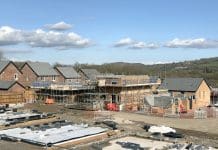Jon Reeds, Convenor of the Smart Growth UK coalition argues that to solve our housing shortage, we should examine our approach to residential densities and concentrate development within conurbations…
One of the oddest aspects of the UK’s “housing crisis” is that few people agree on what actually constitutes it. Pretty well everyone agrees more homes are needed but, once you get down to issues of location, tenure and design, it’s about as consensual as a loose scrum at the Rugby World Cup.
Oddities abound. Why do we get so hung up about “household” formation, when the number that forms it is wholly dependent on the size of the housing stock? Why do we push market housing hardest when the biggest need is for social? Why do we make such poor use of the homes we have?
There are, however, other questions whose answers should inform our response to these issues, but which seldom even get asked.
Why does a densely populated country like this one build its homes at the lowest density in Europe? Why do we persist in building them at out-of-town locations that increase the distance we drive, when almost everyone now agrees we must reduce greenhouse gas emissions by 80%? Why does a country in an increasingly unstable world with a fast-growing population that only produces two–thirds of its food think farmland is a good place to build houses? And why does a country with such a rich appreciation of its history insist on ignoring past experience?
One country that has learned these lessons after pursuing urban sprawl and car dependency even harder than we did is the United States. People are often astonished to discover the land of “hypersprawl” and 18-lane freeways has been increasingly turning its back on such horrors for more than 20 years now.
Its Smart Growth movement has successfully brought regeneration of traditional cities, curbs on sprawl, higher density development, public transport, walkable and cyclable neighbourhoods and revived main streets to communities large and small across the country. City after city is building light railways or metros, the traditional townscape is being protected and housing densities are climbing. It’s those endless sprawling “boomburbs” miles from anywhere useful that are now suffering economic decline.
In the UK, however, people are still surprised to discover what a densely populated land this is. Parts of Scotland and Wales may have fairly low densities, but much of England is pretty rammed. In 2008 England overtook the Netherlands as Europe’s most densely populated country, by which time an average of 395 people were packed into every square kilometre.
But the really bizarre thing is that, for almost 100 years, we have built our towns and cities at some of the world’s lowest densities. Victorians and Edwardians could build wonderful, compact townscape of houses (not the flats which are developers’ only response to density demands) with amenity space at 75 homes per hectare or even higher.
Then the garden city and garden suburb movement decreed low density – maximum “12 to the acre” was the priority, and that remains the paradigm to this day. In 2010, Whitehall even abandoned a very low minimum density of 30 dwellings per hectare, a move perhaps motivated by builders’ belief it is most profitable to build as few homes on a given plot as possible, not as many. So, increasing residential densities would produce more homes at a stroke.
Although politicians would have you believe the housing crisis is caused by planners’ failure to make enough land available, it’s the way we squander it and our regionally unbalanced economy that’s at the heart of this crisis. The Treasury line is simply to release as much land for housing as possible wherever possible, even in parts of England where habitable houses can be bought for £40,000 and the market is close to collapse. There are more of these than one might imagine.
And, for a whole host of reasons, we need to concentrate development within conurbations, where use of low-carbon transport alternatives to the private car is so much easier. We need to ensure development is walkable and well served by public transport.
And we need regional policies to move jobs where the people are, rather than expecting people to chase the jobs. London might have too few homes for its workers but, looked at another way, it actually has too many jobs for its infrastructure. It’s no longer the case that we can’t buck the market; we can no longer afford not to.
Those profiting from the greenfield binge of recent years are quick to stress the expense of reclaiming brownfield sites, but omit to mention that urban extensions and new settlements place far higher demands on the public purse for new infrastructure.
Brownfield development usually allows better use to be made of existing facilities and doesn’t destroy the ecosystem services that greenfield does. Our countryside provides all our water, most of our food, flood control, biodiversity, outdoor leisure and much else besides. We destroy it at our peril.
We need to relearn the lessons our Victorian ancestors taught us. They tackled the industrial slums and left us a fine legacy of compact, communitarian and sustainable cities, well served with sustainable transport.
We have spent 100 years pulling that legacy apart and need to relearn those lessons. If America can learn them, I’m damned sure we can.
Jon Reeds is the author of Smart Growth – From Sprawl to Sustainability and is published by Green Books. ■
. . . . . . . . . . . . . . . . . . . . . . . . . . . . . . . . . . . . . . . . . . . . . . .
Jon Reeds
Convenor
Smart Growth UK
info@smartgrowthuk.org













